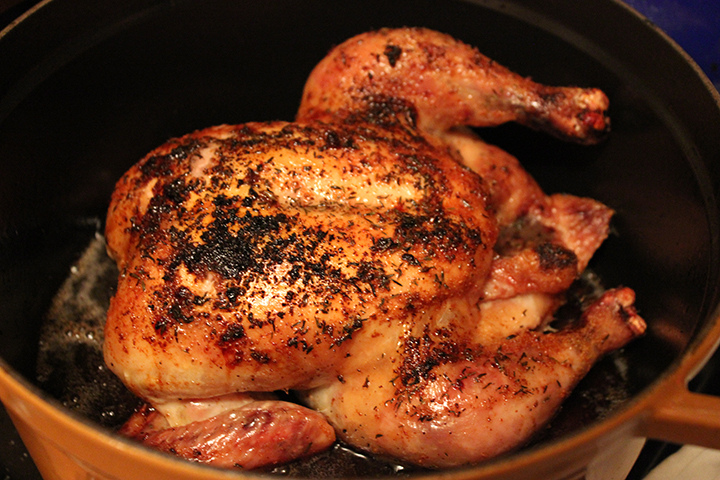Simplest dry-brined roast chicken

Roast chickens and I go way back. First of all, I adore them. How cute are they with their little legs and motor-boat-y breasts? My only problem is that I tear into them WAY too fast, leaving their previously beautiful looking golden bodies appear like they were left alone with a coyote.
The first time I ever roasted one, I was trying to impress someone and got really complicated with a fancy recipe and I served the chicken upside down. So much for that. If someone told me how easy it was to make a delectable & impressive bird, then I would have NEVER gone through the fuss.
Most people are intimidated by the sight of this thing like woooooaaaah are you serious? That slimy thing is gonna go into my kitchen? I’m not ready for that. Yes, you are, right now. Today.
The key to making a juicy bird with CRISPY exterior is to brine it. For chickens, I like a dry brine. Wet brines are awkward and remind me of a fun past-time called the salmonella shitshow that I would like to revisit never. So, dry brines are where it’s at. Also, a lot of people put fat right on the skin like butter or olive oil but this hinders the crisping process. The fat creates moisture which is enemy of the crisp.
I like this recipe because it has two ingredients. If you’re like are you serious, TWO freaking ingredients, chicken and salt? That’s it? You’ve obviously never had chicken fat. This just takes some planning ahead because you have to start it two or three days ahead. I’ve included some optional aromatics but they are very, very optional.
Let’s do it.
Simplest dry-brined roast chicken
Ingredients
1 whole chicken, innards removed, about 3-5 pounds
Kosher salt & pepper
1 tablespoon ghee or olive oil
Dijon mustard or lemon
Optional: lemon halves, herbs, garlic cloves, onion, your favorite spice blend
Directions
2-3 days (ideally 3) before you plan to roast the bird, cover it generously with kosher salt, on the inside and outside. I like to say about 1 teaspoon per pound. It seems like a lot but it’s not.
After you’re done salting it, put it on a dish and leave it uncovered in the refrigerator for 2-3 days. The thing is, the key to crispy skin is the absence of moisture. Salting and then letting the chicken sit will remove all of the moisture from the skin so you are left with a really dry bird. This is why we can’t skimp on the 2-3 day process.
The day you plan to serve the bird, remove it from the refrigerator and let it sit for one hour at room temperature. Set your oven at 450 degrees F. At this point, you can add some pepper to the bird, along with any spice blends you want. You could also add some aromatics such as garlic, lemon, onion, or herbs inside of the cavity so they can perfume the meat.
In a large dutch oven or roasting pan, place the bird breast-side down. Roast for 30 minutes. Remove from the oven, flip it over so it’s now breast-side up and continue roasting for another 30 minutes, until the bird is golden and beautiful and reaches an internal temperature of 165 degrees F.
Let it rest for 10 minutes, and serve with dijon mustard or lemon slices.
*To make a quick pan sauce from the roasting juices, simply put the dutch oven over medium heat and add some broth/wine/beer/water, and whisk to get all of the gorgeous fond and chicken fat that collects at the bottom of the pot. Reduce for a few minutes, then season to taste with salt and pepper.
How can we work together?
nutrition
coaching
business
coaching
courses
1:1 & group coaching
with intuitive macros
Get customized nutrition through Ashley's signature nutrition framework, Intuitive Macros. It won't be the first nutrition program you've ever done, but it will certainly be your last.
learn more
1:1 & group coaching
for online business
Being healthy starts with learning to cook simple foods in easy, delicious ways with approachable and practical recipes and techniques.
learn more
COURSES & MASTERCLASSES
Our health begins with properly nourishing our bodies with nutrient-dense foods. I believe in bio-individuality: each person requires different types and amounts of food to feel their best. Learn how to eat intuitively for the rest of your life!
Be the first to leave a comment: